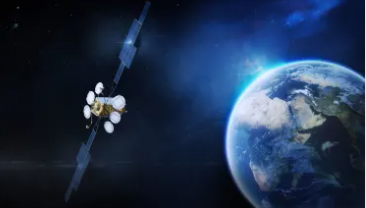- define Downlink and Uplink service areas per Beam according to where missions and Anchoring Stations are located;
- allocate RF power per Channelizer (EUTELSAT QUANTUM “transponder”);
- allocate bandwidth within assigned spectrum bands to each Channelizer and define frequency plans (both Uplink and Downlink).
For decades, satellite communications have enabled governments, businesses and people to communicate over long distances that were previously thought impossible. Despite their significant advantages, satellite communications have always been relatively fixed to the reach and performance they provide. All of that is about to change with EUTELSAT QUANTUM.
What is EUTELSAT QUANTUM?
EUTELSAT QUANTUM heralds a new era of commercial satellite service, where government organizations will be able to actively define and shape the performance and reach from a satellite, as needed.
It is the first commercial Ku-band satellite to have a fully flexible payload that can be remotely configured by software from a user’s premises. It can be controlled not only by Eutelsat, as the satellite operator, but also by the client, who can control their payload and implement operational scenarios according to their mission requirements.
What does EUTELSAT QUANTUM offer?
EUTELSAT QUANTUM’s flexible and responsive approach to satellite communications has a wide array of applications and functionality that organisations can take advantage of. Here are a few of the primary features a software-defined satellite, like EUTELSAT QUANTUM offers.
Unprecedented customization and flexibility
Service areas can be defined and modified in orbit, along with power allocation and frequency plans. This operational flexibility and agility is unparalleled in the world of commercial SATCOM (COMSATCOM) services.
Resources are automatically managed for each user, while taking into account other user configurations and any coordination constraints within the vicinity of the EUTELSAT QUANTUM satellite.
With EUTELSAT QUANTUM, users will have the possibility, via their dedicated, secure interface, to create mission-customized configurations for every use case. They can:
Real-time response to evolving requirements
Sometimes, events occur that are unpredictable or out of anyone’s control. These events are incredibly common in terms of short-notice missions, emergencies and disaster recovery scenarios. Currently, this has caused concern for the reliability of inflexible communications. Should a satellite not offer the necessary reach, or encounter interference, it simply will not be able to adapt to circumstances as they arise.
With EUTELSAT QUANTUM, this challenge is a concern of the past. EUTELSAT QUANTUM can identify and adapt to situations that require communication streams to be flexible. With splittable, shapeable and steerable beams that can be dynamically configured to match the needs of any case, EUTELSAT QUANTUM is ideal for rapid mission implementation, including disaster recovery situations. In addition, it comes equipped with the latest encryption technology for the best in secure and reliable communications.
Optimisation of resources
Sovereign satellites using military bands for SATCOM services (MILSATCOM) are operated and controlled by government organizations. Despite significant recent technological advances onboard satellites, their payload design has remained largely unchanged over the last few decades. When payload flexibility was required, it was usually implemented using conventional non-flexible equipment integrated in the transponder chain. This design philosophy resulted in payloads with weight, power and costs in direct correlation with the mission’s level of flexibility, resulting in a “flexibility penalty”.
Flexibility depends on the number of hardware options selectable. For example, two antennas can provide coverage in two predefined areas, but cannot provide intermediate options. Steerable antennas provide an additional level of flexibility, but usually with a predefined spot beam pattern.
By implementing a payload that can be fully controlled by software and onboard phased array antennas, EUTELSAT QUANTUM opens the door to a new generation of commercial satellites, offering users increased control and unprecedented flexibility for their missions.
Direct control, remotely
For the first time, a universal satellite will be able to repeatedly respond and adjust to requirements sent from terrestrial sources. As noted above, this can dynamically adapt to situations, but organisations can directly control it to meet their needs. This unique capability has been made possible thanks to the EUTELSAT QUANTUM remote control system enabling users to become Virtual Satellite Operators (VSO).
The CMRS (Communication Mission Reconfiguration Software) manages the satellite resources, optimizing them for each user. This makes it possible to define new operating procedures to implement Ku-band SATCOM services for government communications - virtualizing satellite service control operations by users.
The secure, autonomous interface enables the Secure Virtual Satellite Operator (SVSO) to perform planning activities and issue configuration orders for specific SATCOM mission needs from a segregated and controlled environment.
Get ready for the QUANTUM difference.
EUTELSAT QUANTUM is set to transform what’s possible for satellite communications. As the first software-based, truly flexible universal satellite offering, it will be the benchmark that defines adaptable communication for the future.
EUTELSAT QUANTUM will launch in the coming months, and be located at 48° East. It will offer extensive coverage over EMEA and Central Asia regions.
If you would like to find out more about the solutions that will define communication for the near future, contact Eutelsat today, or find out more about the EUTELSAT QUANTUM satellite here.



